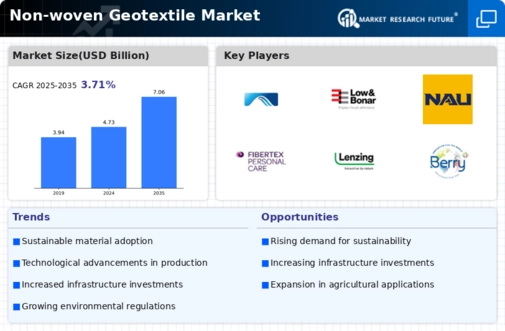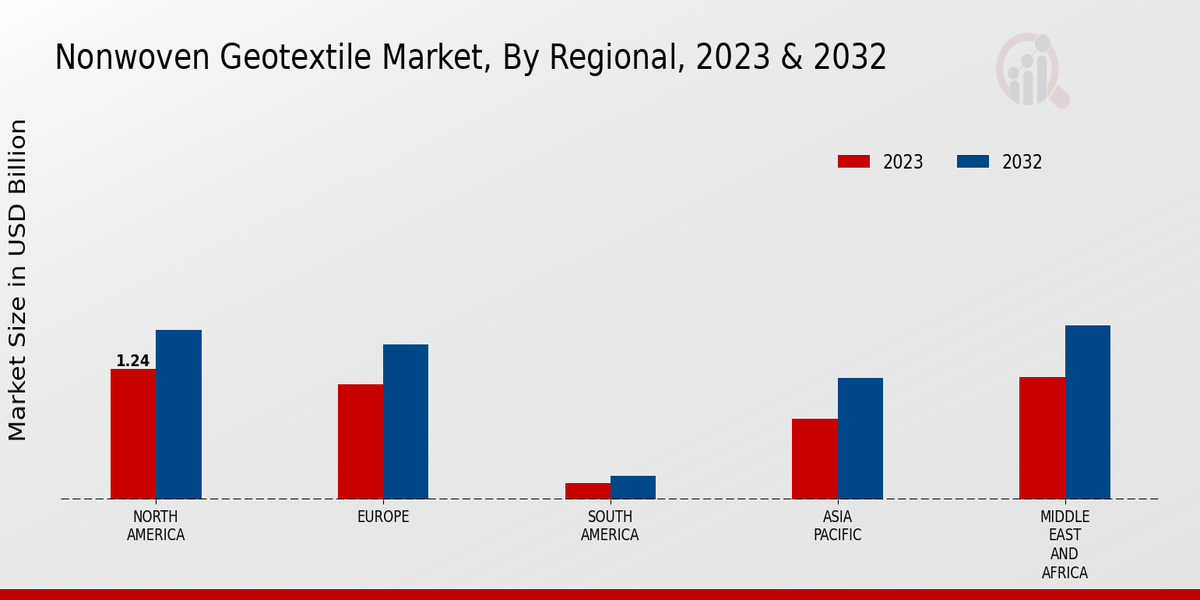Market Growth Projections
The Global Non-woven Geotextile Market Industry is poised for substantial growth, with projections indicating a market size of 4.73 USD Billion in 2024 and an anticipated increase to 7.06 USD Billion by 2035. This growth trajectory reflects a compound annual growth rate (CAGR) of 3.71% from 2025 to 2035, driven by various factors such as infrastructure development, environmental regulations, and technological advancements. The market's expansion is indicative of the increasing reliance on non-woven geotextiles across multiple sectors, including construction, agriculture, and environmental management, highlighting their versatility and essential role in modern applications.
Increasing Infrastructure Development
The Global Non-woven Geotextile Market Industry experiences a notable boost due to the increasing infrastructure development across various regions. Governments are investing heavily in infrastructure projects, including roads, bridges, and drainage systems, which require effective soil stabilization and erosion control solutions. Non-woven geotextiles serve as a vital component in these applications, enhancing durability and longevity. For instance, in 2024, the market is projected to reach 4.73 USD Billion, reflecting the growing demand for these materials in construction. This trend is expected to continue, with the market potentially reaching 7.06 USD Billion by 2035, indicating a robust growth trajectory driven by infrastructure needs.
Growing Awareness of Soil Erosion Issues
The Global Non-woven Geotextile Market Industry is increasingly shaped by the growing awareness of soil erosion issues and their impact on the environment. As communities and governments recognize the detrimental effects of erosion on land and water resources, there is a heightened demand for effective erosion control solutions. Non-woven geotextiles provide a practical approach to mitigating soil erosion, making them a preferred choice in various applications, including landscaping and civil engineering. This awareness is likely to drive market growth, as stakeholders seek sustainable solutions to combat erosion and protect natural resources, further solidifying the role of non-woven geotextiles in environmental conservation.
Rising Demand in Agricultural Applications
The Global Non-woven Geotextile Market Industry benefits from the rising demand for agricultural applications, particularly in soil stabilization and crop protection. Farmers increasingly utilize non-woven geotextiles to improve soil quality, manage water retention, and prevent erosion. These materials are instrumental in enhancing agricultural productivity, especially in regions prone to soil degradation. As agricultural practices evolve, the market is expected to witness substantial growth, with projections indicating a compound annual growth rate (CAGR) of 3.71% from 2025 to 2035. This trend underscores the importance of non-woven geotextiles in supporting sustainable agricultural practices and ensuring food security globally.
Environmental Regulations and Sustainability
The Global Non-woven Geotextile Market Industry is significantly influenced by stringent environmental regulations that promote sustainable practices. Governments worldwide are increasingly mandating the use of eco-friendly materials in construction and civil engineering projects. Non-woven geotextiles, made from recycled materials, align with these sustainability goals, offering effective solutions for erosion control and filtration. As a result, the demand for these products is likely to rise, driven by regulatory compliance and a growing emphasis on environmental stewardship. This shift towards sustainability not only enhances market growth but also positions non-woven geotextiles as a preferred choice in various applications, further solidifying their role in the industry.
Technological Advancements in Material Production
The Global Non-woven Geotextile Market Industry is propelled by technological advancements in material production processes. Innovations in manufacturing techniques have led to the development of high-performance non-woven geotextiles that offer enhanced durability, filtration, and drainage capabilities. These advancements not only improve product quality but also reduce production costs, making non-woven geotextiles more accessible to a broader range of applications. As technology continues to evolve, the market is likely to expand, driven by the introduction of innovative products that meet the diverse needs of various industries, including construction, agriculture, and environmental management.




















